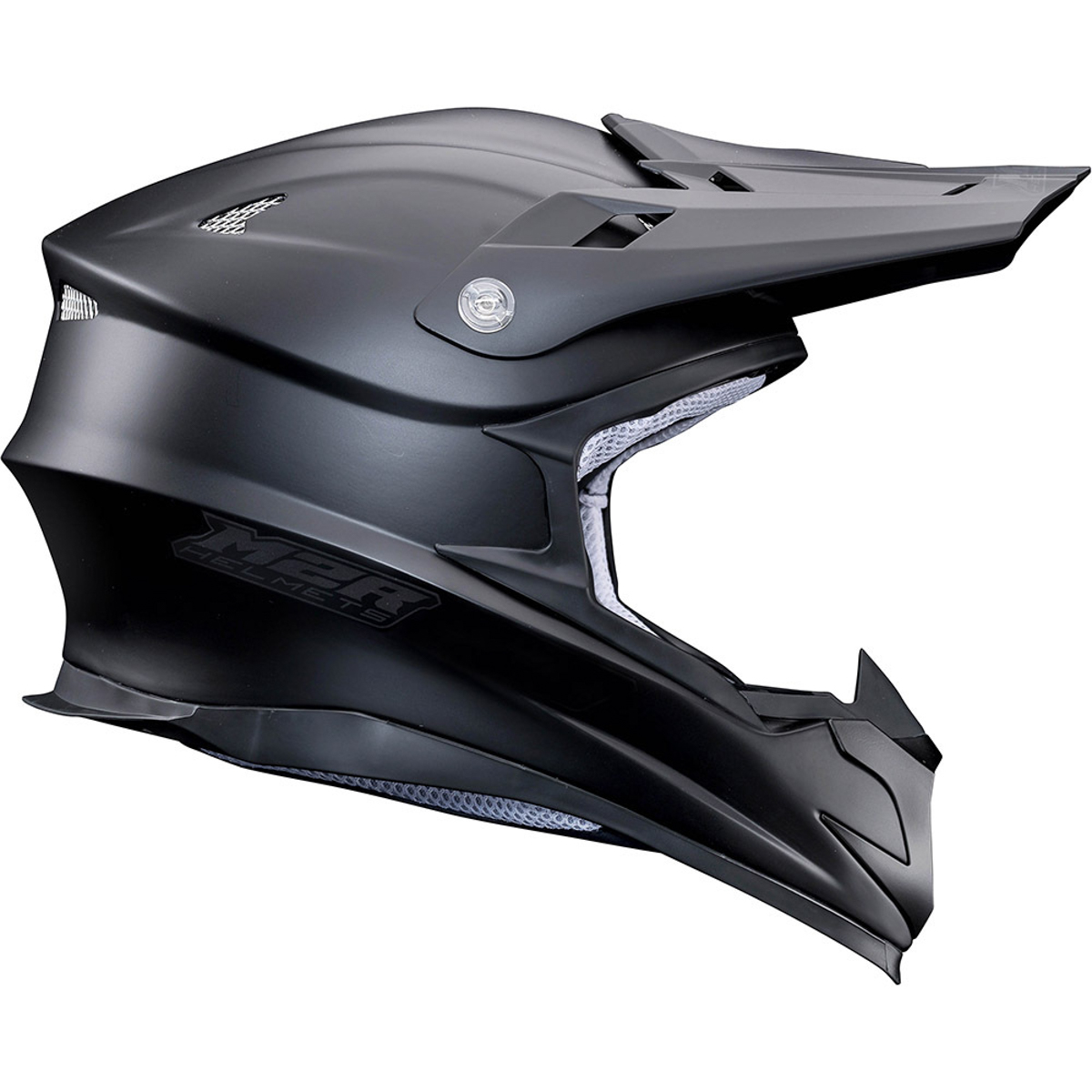The MXstore Helmet Buying Guide

When it comes to choosing a dirt bike helmet, there's plenty to think about and hundreds of options to consider.
In this buyer's guide, we answer the key questions you should be asking yourself before pulling the trigger on a new lid.
How do I choose the right size helmet?
No matter how much money you spend on a helmet, the fact is if it doesn’t fit you correctly your safety will be severely compromised. The easiest way to explain this is you want your helmet to feel snug - a helmet that fits you correctly will be tight around your cheeks, if your teeth are catching some of your cheeks while you talk with a helmet on that is perfect.
Also check the back of the helmet where the base of the helmet meets the back of your head, this should also be a snug fit so if you can fit your fingers in between here the helmet is too big!
When ordering online knowing your measurements is going to be your biggest advantage, all helmets are sized in S (small), M (medium), L (large) increments. There is a range of CM measurements associated with each size too. To accurately measure your head, use a cloth tape measure wrapped around your head horizontally about one inch above your eyebrows and ears, take the CM measurement of the circumference of your head.

Adult Helmet Sizes:
XS (extra small) 53-54cm
SM (small) 55-56cm
MD (medium) 57-58cm
LG (large) 59-60cm
XL (extra large) 61-62cm
2XL (2 extra large) 63-64cm
Kids Helmet Sizes:
Small 47-48cm
Medium 49-50cm
Large 51-52cm
X-Large 53-54cm
Please note: Always aim to get a tight-fitting helmet, if you fall between sizes round the size down, not up. The exception to the rule being kids helmets as they are growing you would be safe to round up to the nearest CM to allow for room to grow. Everyone has a slightly different shaped head, and most helmets are a slightly different fit from brand to brand. Try as many on as you can until you find a brand which is the right shape for your head as the better the fit, the safer the ride!
What should I look for in a helmet?
When it comes to buying a full-face motocross helmet, you need to take into consideration a number of things before pulling the trigger on a purchase.
Budget: The first thing you need to consider when buying a motocross helmet is how much you want to spend, or how much you can afford to spend. A dirt bike helmet is the most important piece of protective gear, so we recommend putting as much of your budget into one. This is not an area you want to skimp out on.
Fit: Every helmet fits differently, so don't always assume that because one brand fits you perfectly, that another brand will too. Some brands fit some head shapes better than others, and that's why we always recommend trying a helmet on before purchasing where possible. This will enable you to get to the comfiest and most well-fitting helmet - and a well-fitting helmet is a protective helmet.
Protection & technology: Helmet technology has come leaps and bounds in the last decade, which is why it's something you need to consider. The latest technology is generally always equipped on top-tier helmets, so it does come at a cost, but it's a cost well-worth it as this technology will give you the best protection possible. You can learn more about helmet technology here: Dirt Bike Helmet Technology Guide

Style: Last on the list for consideration, but still making it on here, is the style of the helmet. Generally, the style of a helmet is why we're drawn to a particular off-road lid, but it should be the last thing to think about. Why does it still make the list? Well, helmets are expensive, and as long as you don't suffer a heavy fall, you're likely to wear them for 1-3 years. We recommend choosing something you're still going to be stoked on a years' time, and something that will still pair up will with your riding kit in the years to come.
What's the difference between entry-level and premium helmets?
Sub-$450 helmets: The sub-$450 helmet category is the entry-level for off-road moto riders. This category will generally see helmets that meet the required ECE certification, however they'll generally have a somewhat basic construction with minimal features, such as limited venting and a standard fit and feel. An entry-level helmet is perfect for riders who are new to the sport, learning the ropes, and taking things slowly.


$450-$700 helmets: The $450-$700 is the most popular range of dirt bike helmets, and here you'll find a step further in protection, ventilation, and comfort. Many helmets in this range will utilise the MIPS system, boast a number of intake and exhaust vents, along with having a more fitted feel with comfier cheek pads and liner. This segment of moto helmets is recommended for riders who a riding at a level above beginner, where they'll be reaching higher speeds.


$700-plus helmets: The $700-plus helmet market is where you'll find the latest and most advanced helmet technology and protection. The lids in this segment are lightweight and often carbon helmets, offer advanced ventilation systems, and have superior comfort and fitment. The advanced technology built into these helmets is generally exclusive to the manufacturer, such as the technology found on the Bell Moto-10 Spherical and 6D ODS. We recommend a helmet in this segment to riders who are racing, and those who want the maximum in head protection.
.jpeg)
.jpeg)
What certifications should I look for?
There are a number of companies that perform testing and provide approval for motorcycle helmets in Australia. Depending on the company will determine what the approval sticker looks like, a common one is the 'Five red ticks', but we have added an image to help you identify some of the different stickers currently in circulation.
The common piece of information on all of these stickers is the Australian approval number being either:
AS/NZS 1698
AS/NZS 1698-2006
The second code is a newly revised code and all helmets moving forward will contain the longer number.
In 2016 the rules and standards were updated for all states throughout Australia. The update to the Australian standard now allows the United Nations Economic Commission for Europe (ECE) 22.05 standard.
Helmets must display either a stitched label on the inside of the helmet or a sticker on the outside of the helmet, indicating compliance with the approved standards.
For a helmet meeting the ECE 22.05 standard, the label or sticker may contain any number from 1 upwards. Some examples are shown below.


Here are some basic facts about the changes to what is now legally accepted as mandatory approved helmet standards throughout Australia:
- All Australian and Territories now recognise both ECE 22:05 and AS/NZS 1698:2006 as the mandatory approved helmet standards for vehicle users. - To be completely clear, AS/NZS 1698:2006 has not been dropped as an approved standard, nor will it be in the near future. There are no plans to make any changes at all to this standard. - Helmets complying to AS/NZS 1698:2006 are still legal to sell and use in all states and territories of Australia as there are many helmets for sale and/or in circulation so no changes to the acceptance of the Australian standard will be made in the foreseeable future.
Some Australian importers will continue to bring in selected models under this standard. Some helmets models are either not available for sale in Europe or not designed/manufactured for that standard so the AS/NZS 1698:2006 standard will continue to be created.
Markings on helmets:
On ECE 22:05 approved helmets the only requirement is for the certification code to be attached to the retention strap.
No external stickers are required.
AS / NZS 1698 approved helmets will continue to be marked as they always were.
If you are having your helmet custom painted, make sure you do not remove the safety sticker as this will also make the helmet void of its approval.
DOT certification is an American standard with a lower testing threshold, and is not a compliant certification in Australia or outside of the US.
What's the difference a dual-sport helmet and motocross helmet?
Motocross and dual sport helmets are very similar, however they boast key differences that make them more suitable for different types of motorcycle riding.
Whether you're an adventure or dual-sport rider, it can be hard to decide on what type of helmet to choose. We highlight which helmet is suited best for different styles of riding.
.jpeg)

Motocross helmet: Motocross helmets are designed for purely off-road riding, whether that be motocross itself or even enduro and trail riding. There's an abundance of motocross full face helmets available at all sorts of price points, while the premium lids feature the latest in helmet technology. They're usually aggressively designed, and they do require motocross goggles, which is something to consider.
The verdict: A motocross helmet is really for riders who tend to do more off-road riding than road riding. There are a couple of things to keep in mind if you're choosing an MX helmet - the first is that there will generally be more wind noise, especially travelling on highways, plus the use of goggles means water and wind will hit your face and make its way into the helmet. We recommend a dirt bike-specific helmet if your riding predominantly off-road since they are typically lighter and offer greater ventilation.
Dual sport helmet: Dual sport helmets are essentially a mix between a motocross helmet, and a normal motorcycle helmet. They have a 'rounder' design compared to an MX specific helmet and use a visor/face shield, although they feature a peak just like a motocross helmet. Dual sport ranges are usually limited in selection, with most brands offering just a single model in their line-up.
The verdict: If you're more of an adventure rider, or you do your fair share of commuting on the road, then a dual sport helmet is perfect for you. They're still very capable when you want to go off-road, but they will just make the riding experience much more enjoyable when you're on the bitumen by reducing wind noise and blocking wind and water from entering the helmet.
Learn more about dirt bike helmets:
How To Wash Your Motocross Helmet
Ultimate Guide to Dirt Bike Helmets
Dirt Bike Helmet Technology Guide
Entry-Level Dirt Bike Helmet Comparison
Mid-Level Dirt Bike Helmet Comparison
Premium Dirt Bike Helmet Comparison
Popular dirt bike helmet brands:
6DAcerbis
Airoh
Alpinestars
Answer
Arai
Bell Helmets
Fly Racing
Fox Racing
JUST1
M2R
Nitro Helmets
Oneal
RXT
Shift
Shoei
Thor
Troy Lee Designs















Comments (1)